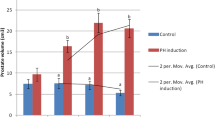Summary
The results of hormonal investigation of effects of an antiandrogen, Oxendolone (OXD), alone or in combination with medroxyprogesterone acetate (MPA), on experimentally induced canine BPH are reported. Seventeen beagle dogs were divided into 5 groups: 2 castrate controls for. Group 0, 3 BPH controls for Group 1 which received 3α-androstanediol (3α-A) and estradiol (E2) for one year, and 12 dogs consisting of 3 groups which received 3α-A and E2 for 6 months followed by testosterone propionate (TP) and E2 for another 6 months. The last 3 groups were treated with either 200 mg/week of OXD (Group 3) or OXD+30 mg/week of MPA (Group 4), and otherwise untreated with these hormones (Group 2, T-E controls). On the blood hormone analysis, both T and 5α-dihydrotestosterone (DHT) were generally lowered in the T-E administered groups (Group 2, 3 and 4) compared to those in Group 1. While MPA significantly descreased these androgen levels, OXD did not influence at all. The concentrations of E2 were similar. Although T content in the prostate did not differ significantly within the experimental groups, DHT was the highest in Group 1 and the lowest in Group 4 and was nearly the same level to Group 0. MPA reduced tissue DHT content but OXD did not. In the receptor assay study, nuclear androgen receptor (AR) content in Group 3 and 4 was significantly lower than that in Group 1. No obvious decrease in nuclear AR content could be seen among the other groups. Significant differences were not observed in both the cytosol AR contents and in the cytosol and nuclear estrogen receptor (ER) contents, although they were generally low in Groups 3 and 4.
Similar content being viewed by others
References
Bradford MM (1976) A rapid and sensitive method for the quantitation of microgram quantities of protein utilizing the principle of protein-dye binding. Anal Biochem 72:248–254
Chiasiri N, Volataire Y, Evans BAJ, Pierrepoint CG (1978) Demonstration of a cytoplasmic receptor protein for estrogen in the canine prostate gland. J Endocrinol 78:131–139
deKlerk DP, Coffey DS, Ewing LL, McDermott IR, Reiner WG, Robinson CH, Scott WW, Strandberg JD, Talalay P, Walsh PC, Wheaton LG, Zirkin BR (1979) Comparison of spontaneous and experimentally induced canine prostatic hyperplasia. J Clin Invest 64:842–849
Ekman P, Barrack ER, Greene GL, Jensen EV, Walsh PC (1983) Estrogen receptors in human prostate: Evidence for multiple binding sites. J Clin Endocrinol Metab 57:166–176
Garola RE and McGuire WI (1977) An improved assay for nuclear estrogen receptor in experimental and human breast cancer. Cancer Res 37:3333–3337
Hosaka M (1976) Studies on plasma 5alpha-dihydrotestosterone (Japanese). Jpn J Fertil Steril 21:135–149
Huggins C (1947) The etiology of benign prostatic hypertrophy. Bull NY Acad Med 23:696–704
Kambegawa A (1975) Estrogen (Japanese). The Saishin-Igaku 30:790–798
Labarca C, Paigen K (1980) A simple, rapid, and sensitive DNA assay procedure. Anal Biochem 102:344–352
Lax ER, Baumann P, Schriefers H (1984) Changes in the activities of microsomal enzemes involved in hepatic steroid metabolism in the rat after administration of androgenic, estrogenic, progestational anabolic and catabolic steroid. Biochem Pharmacol 33:1235–1241
Makino T, Inatomi K, Yoshida T, Tayoshi T, Takagi S, Kambegawa A (1973) Radioimmunoassay of sex steroid hormones (Japanese). Clin Endocrinol 21:867–873
Masuoka M, Masaki T, Yamazaki T, Hori T, Nakayama R (1979) Anti-androgen TSAA-291 III. Hormonal spectra of antiandrogen TSAA-291 (16β-ethyl-17β-hydroxy-4-oestren-3-one) and its derivatives. Acta Endocrinol [Suppl] (copenh) 92 229:36–52
Moore RJ, Gazak JM, Wilson JD (1979) Regulation of cytoplasmic dihydrotestosterone binding in dog prostate by 17β-estradiol. J Clin Invest 63:351–357
Nakayama R, Masuoka M, Masaki T, Shimamoto K (1979) Anti-androgenic effect of a new steroid TSAA-291 (16β-ethyl-17β-hydrox-4-oestren-3-one) and its derivatives. Acta Endocrinol [Suppl] (Copehnh) 92 229:2–23
Ofner P (1968) Effects and metabolism of hormones in normal and neoplastic prostate tissue. Vitam Horm 26:237–291
O'Shea JD (1962) Studies on the canine prostate gland I. Factors influencing its size and weight. J Comp Rathol Ther 72:321–331
Sudo K, Yoshida K Akinaga Y, Nakayama R (1981) 5α-reduction of an anti-androgen TSAA-291, 16β-ethyl-17β-hydroxy-4-oestren-3-one, by nuclear 5α-reductase in rat prostates. Steroids 38:55–71
Sudo K, Yoshida K, Nakayama R (1982) Specific interaction of radioactive anti-androgen TSAA-291 with androgen receptor in rat prostates. Acta Endocrinol 100:473–480
Sudo K, Masuoka M, Hiraga K, Yoshida K, Nakayama R (1984) Radioimmunoassay for serum levels of an anti-androgen TSAA-291 (Oxendolone) in rats. J Pharm Dyn 7:378–384
Trachtenburg J, Hicks LL, Walsh PC (1980) Androgen- and estrogen-receptor content in spontaneous and experimentally induced cainine prostatic hyperplasia. J Clin Invest 65:1051–1059
Walsh PC, Wilson JD (1976) The induction of prostatic hyperplasia in the dog with androstanediol. J Clin Invest 57:1093–1097
Wilson JD, Gloyna RE, Siitetri PK (1975) Androgen metabolism in the hypertrophic prostate. J Steroid Biochem 6:443–445
Author information
Authors and Affiliations
Additional information
Nomenclature and abbreviations of hormones used in this paper are indicated in Part I
Rights and permissions
About this article
Cite this article
Okada, K., Oishi, K., Yoshida, O. et al. Study of the effect of an anti-androgen (Oxendolone) on experimentally induced canine prostatic hyperplasia. Urol. Res. 16, 73–78 (1988). https://doi.org/10.1007/BF00261959
Accepted:
Issue Date:
DOI: https://doi.org/10.1007/BF00261959




